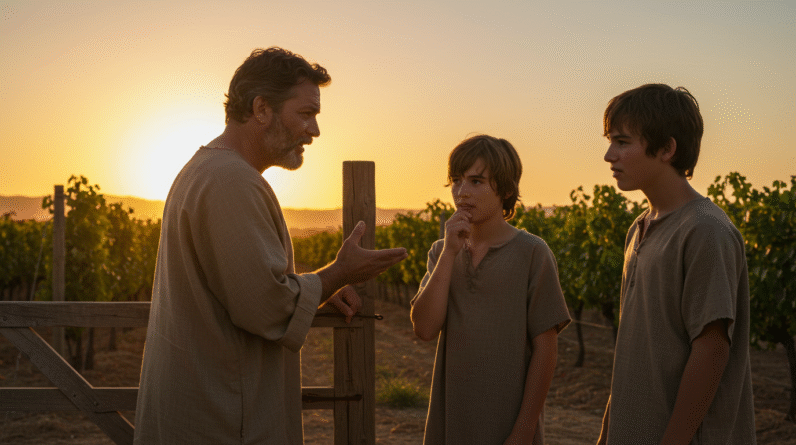The Parable Of The Good Samaritan – Loving Your Neighbor In Action
You’ve probably heard the Parable of the Good Samaritan a hundred times. It’s one of those Bible stories that shows up everywhere — sermons, Sunday school, charity appeals — and yet it still has the power to confront you in a fresh, sometimes uncomfortable way. Jesus told this story in response to a pointed question about eternal life and neighborly responsibility, and you can read the full account in Luke 10:25–37. When you look closely, you discover that it’s not just a feel-good tale; it’s a disruptive call to action for how you live among other people.
When you read a passage like this, you don’t want it to stay only in your head. The phrase Parable of the Good Samaritan explained invites you to dig into the story’s meaning, unpack the cultural background, and apply it to the messy realities of your life. In the paragraphs that follow, you’ll find historical context, a verse-by-verse walk-through, practical steps you can take today, and ways to teach this truth to others so the story produces real change in your community.
The setting: Why Jesus told this parable
Jesus told the parable after a lawyer — an expert in religious law — tested him with a question. You can see the setup in Luke 10:25–37, where a conversation about the law becomes a teaching moment about love and action. The lawyer asks, “What must I do to inherit eternal life?” and Jesus turns the question back to him. The lawyer quotes the greatest commandments and then tries to justify himself by asking, “Who is my neighbor?” That follow-up question is the spark that leads to the story.
Understanding the setting helps you see what Jesus is doing: he’s refocusing religious debate from technical correctness to compassionate practice. The parable was told in a culture of clear social boundaries — Jews and Samaritans didn’t mix — which makes the punch of the story even stronger when the unexpected hero appears. When you remember the cultural tensions behind the tale, the parable hits you like a mirror, asking, “Who are you willing to love?”
A close look at the story (verse by verse)
If you want the full passage, read Luke 10:25-37 now. Jesus tells of a man traveling from Jerusalem to Jericho who is waylaid by robbers, left half-dead. A priest and then a Levite pass by without helping. Finally, a Samaritan comes along, feels compassion, treats the wounds, pays for lodging, and promises to cover additional expenses.
Each detail matters. The priest and Levite represent religious authority who should have shown mercy, but they didn’t. The Samaritan, traditionally despised by Jews, becomes the unexpected model of neighborly love. Jesus flips expectations so that the one you’d least expect to act like a neighbor becomes the one who does. When you read the story in this way, you see that neighbor-love crosses ethnic, religious, and social boundaries. That reversal is central to how you should live.
When you study the Parable of the Good Samaritan explained, you’ll notice Jesus is not letting theological knowledge replace loving action. The lawyer’s question “Who is my neighbor?” gets answered by a story that defines neighbor not by proximity or similarity, but by compassionate action. That’s a core move in Jesus’s teaching: faith is active, visible, and sacrificial.

Who is the “neighbor” in Jesus’s eyes?
The lawyer wanted a narrow definition of neighbor so he could limit his obligations. Jesus refuses to give a technical definition. Instead, he gives an example: the neighbor is the one who shows mercy. By showing you the Samaritan’s actions, Jesus redefines neighbor as “the one who acts with compassion.”
You can’t reduce neighborliness to a legal category. That’s why the Parable of the Good Samaritan explained becomes so radical: your neighbor is not just the person who lives next door or shares your identity. Your neighbor is the person you see in need and whom you help — regardless of race, religion, status, or past conflict. This redefinition forces you to put love into practice, not just talk about love as a category.
If you watch carefully, Jesus’s point is plain: the role of neighbor is assigned by the willingness to act. That call applies to you today. The person in need — the wounded traveler — comes to you wherever you are: at work, in a city street, in your online community, or in a different country via a news story. When you see suffering, your neighborly duty is to respond.
The moral contrast: Religion without compassion
One of the most striking features of the story is who fails to act. The priest and the Levite, representatives of religious life and ritual purity, avoid the wounded man. Their failure indicts a religion that values ritual over mercy. Jesus wants you to see that religion can become an idol if it doesn’t lead you to help the hurting.
When you think about faith, don’t let religious routines become excuses for inaction. Jesus makes it clear that religious identity without practical compassion is hollow. The Parable of the Good Samaritan shows that your religion is tested when help costs you something — time, money, reputation, or comfort. If you’re avoiding people in need because you’re afraid of contamination, inconvenience, or getting involved, the parable says your faith is incomplete.
This is hard medicine. It means that your prayers, church attendance, and Bible knowledge should produce outward compassion. Rituals are not the point; the transformation that leads to mercy is.
Compassion in action: What the Samaritan does
The Samaritan doesn’t just feel pity. He acts. He bandages wounds, pours oil and wine — then standard first-aid of his day — places the man on his own animal, brings him to an inn, and pays for his care. He even promises to pay more if needed. The Samaritans’ care is comprehensive, sacrificial, and costly.
When you read the Parable of the Good Samaritan explained, you see that neighborliness involves direct, tangible care. It’s not enough to offer a prayer or a platitude from a distance. The Samaritan touches the hurting man, uses his own resources, and pays the innkeeper to ensure continued care. That level of commitment is the measure Jesus holds up for you.
So how does that translate to your life? It means you will sometimes have to get personally involved — pick up a wounded neighborhood kid, sit with a grieving friend, call a struggling co-worker, donate to cover a bill, or advocate for someone who can’t speak for themselves. The Samaritan acted without counting the cost; that’s the kind of love Jesus commends.
Parable of the Good Samaritan explained: Why Jesus uses a Samaritan
Samaritans and Jews shared a common ancestry but were divided theologically and culturally. Jews often despised Samaritans as religious heretics and social outcasts. Jesus deliberately makes a Samaritan the hero to confront prejudice and show that goodness is not confined to your tribe.
When you think about prejudice in your own life — whether racial, political, denominational, or socioeconomic — the story challenges you. The Parable of the Good Samaritan explained that God’s love breaks through your categories. You’re called to treat people with compassion even when society has told you to avoid them. Your neighborliness is not conditional on agreement, similarity, or mutual liking. Love crosses lines.
That’s a corrective for how you live in your community. If you only love the lovable, you’ve missed the point. Jesus used the Samaritans to teach you that mercy is the litmus test of true faith, not cultural affinity.
Practical steps to become a neighbor in your daily life
You probably want real, doable steps, not just inspiration. Here are practical ways to live out what the Parable of the Good Samaritan explained calls you to:
- Begin with awareness: watch for people in need in your daily rhythms — at work, in your street, online, or at church.
- Prepare resources: keep an emergency fund, know local social services, and build a network of people who can help.
- Act compassionately: offer direct help — a meal, a ride, a listening ear, a referral — and follow up.
- Remove prejudice: intentionally build relationships with people outside your usual circles.
- Teach and model: encourage your family, small group, or church to serve in practical ways.
Each one of these steps is a paragraph-long practice in your life. When you adopt them, the story stops being something you read and becomes something you live. This is what the Parable of the Good Samaritan explained: not just admiration for the Samaritan, but imitation of his mercy.
When love costs you: Time, money, reputation
Following the Samaritans’ example will cost you. Compassion often means inconvenience, expense, or possible social judgment. The Samaritan used his own resources and risked association with a half-dead stranger. You will be asked to do the same in your context.
When you feel the cost, remember that the gospel frames sacrifice as a form of worship. Giving your time and money to help people isn’t merely a transaction; it’s an expression of the love Jesus gave you. The Parable of the Good Samaritan explained requires that you take risks for others. Sometimes those costs are small; sometimes they’re significant. But each act of mercy is a step toward reflecting the heart of Christ.
Make a plan for the costs. Set a budget for mercy, allocate time in your calendar, and cultivate courage for socially risky compassion. Preparing yourself practically helps you keep compassion sustainable.
Institutional charity vs. neighborly love
It’s tempting to offload responsibility to institutions — charities, churches, or government. While systemic responses are vital, Jesus’s parable emphasizes personal involvement. The Samaritan not only founded a hospital; he personally tended to the wounds and ensured ongoing care.
You need both: you should support reputable institutions that tackle poverty and injustice, and you must also be willing to step in personally where institutional responses fall short. The Parable of the Good Samaritan explained is a corrective to purely institutional compassion. Institutions can scale help, but your immediate, personal engagement models the kind of neighborliness that transforms lives.
Think of institutions as tools, not replacements. Your individual actions give institutions a face and a heart. Your presence beside a hurting person communicates dignity in a way that statistics never will.
What the law teaches and what mercy fulfills
The lawyer in the story quotes the law: Love God and love your neighbor. That formula is the hinge between theology and practice. You can find the command to “love your neighbor as yourself” in Leviticus 19:18, and Jesus echoes the greatest commandment in Matthew 22:37-39. Paul later explains that love fulfills the law in Romans 13:8-10. These links show the consistent biblical trajectory: law points to love; love is action.
When you read the Parable of the Good Samaritan explained alongside these passages, you see a biblical ethic that refuses to separate personal devotion from public compassion. Loving God and loving people are inseparable; if one is missing, your faith is incomplete. This integration should shape how you pray, how you volunteer, and how you vote.
The Samaritan’s generosity teaches stewardship
The Samaritan demonstrates good stewardship: he uses what he has — time, money, a mount, and influence with the innkeeper — for the welfare of another. Stewardship here is not only about managing money but about using your resources as instruments of mercy.
When you practice stewardship with a neighborly heart, you’ll begin to view your possessions as tools for service. That shifts your priorities. Instead of hoarding resources for security or status, you’ll purposefully allocate them to meet real needs. The Parable of the Good Samaritan explained invites you to see stewardship as an act of love, and stewardship done in love magnifies the gospel.
Practical stewardship might mean a dedicated giving fund for emergency needs, volunteer time with local outreach, or skill-sharing with people who can’t afford professional help. When you steward well, your life becomes a conduit of mercy.

The spiritual posture behind neighborly action
Mercy flows from a heart that’s been touched by God. The Samaritan’s compassion isn’t just practical; it’s spiritual. He sees the wounded man not as an inconvenience but as a person in need of mercy. Jesus calls you to cultivate that posture of compassion — a spiritual sensitivity that notices suffering and is moved to help.
You develop that posture through spiritual disciplines: prayer that opens your eyes to need, fasting that deepens empathy, meditation on Scripture that grows your compassion, and regular service that shapes your empathy muscles. When you cultivate a disposition of mercy, helping others moves from obligation to delight. The Parable of the Good Samaritan explained is not only a how-to manual but a call to change your heart.
Practice an “open eyes” spirituality. Ask God to show you one person a week who needs help and then act on what you see. Small disciplines lead to big changes in how you live.
Teaching the parable to children and communities
You’ll want the next generation to grasp this story not just as a tale but as a lifestyle. Teaching the parable to children should emphasize concrete deeds: bandage a teddy bear, role-play a helpful neighbor, or do a simple service project together. For church communities, use the parable to form small groups focused on neighborhood ministry and mercy outreach.
When you teach, make it practical and relational. The Parable of the Good Samaritan explained becomes most effective when learners are given real situations to practice. Encourage local churches to partner with social services, create mercy teams, and mobilize volunteers for immediate response. Teaching this way forms disciples who believe faith leads to action.
Modeling is essential. Leaders must publicly serve so others see neighborly love in action. Your example opens the door for others to follow.
Common obstacles to showing mercy — and how to overcome them
You’ll face obstacles: fear, prejudice, time pressure, financial limitations, and cultural norms that keep you distant. Name these barriers so you can strategize around them. Fear can be reduced by partnering with others; prejudice can be addressed through relationships and education; time constraints can be managed by small, consistent acts of mercy.
The Parable of the Good Samaritan explained shows you that overcoming these obstacles often begins with a decision to do something small. Start with one intentional act this week: bring a meal, make a call, donate to an emergency fund, or listen to someone’s story. Small steps break the inertia and build momentum. Over time, these habits reshape your character and your community.
Remember: there are no perfect solutions, but there are faithful ones. Faithful action wins over paralysis.
When systems need mercy: Justice and neighborliness
Individual acts of mercy are vital, but justice matters too. The road between Jerusalem and Jericho was dangerous because of systemic issues — banditry, lawlessness, and economic vulnerability. The Samaritan addressed the immediate need, but the larger problem demanded systemic change.
As you live out neighborly love, be willing to engage in efforts that address root causes: advocate for safer communities, support policies that reduce poverty, and participate in programs that create long-term opportunity. The Parable of the Good Samaritan explained invites both immediate compassion and long-term justice. When you combine both, you advance the kingdom in a fuller way.
Balance short-term relief with long-term solutions. Both are necessary for healthy communities.
Personal stories: When you’ve been the Samaritan
Think of a time when someone helped you in a way that changed your life. Those memories are powerful motivators. When you internalize the experience of being the recipient of mercy, you become more likely to extend it. The parable calls you to be the kind of person who shows up when someone is vulnerable.
Make a practice of telling and retelling stories of mercy in your circles. Stories mobilize people in ways that statistics do not. The Parable of the Good Samaritan explained becomes alive when you hear about neighbors who were helped and transformed. Encourage your church or small group to share testimonies and to celebrate acts of compassion.
Personal stories build a culture where mercy is normative rather than exceptional.
The Samaritan and the gospel: Christ as your model
Ultimately, the parable points beyond itself to Christ. Jesus is the ultimate Savior who bends down to pick you up, binds your wounds, and bears the cost of your recovery. In your life, you imitate him by doing the same for others. The Samaritan is a picture of God’s grace in action.
When you see Jesus in the Samaritan’s actions, you realize that your neighborliness is a participation in God’s work. It’s not merely about good ethics; it’s about reflecting Christ’s mercy to a hurting world. The Parable of the Good Samaritan explained is an invitation to be conformed to Christ’s compassion.
You respond to this calling not in your own strength but with the Spirit’s power. Pray for boldness, for love that’s practical, and for hands that are willing.
Small group practices to cultivate neighbor-love
If you lead a small group, use the parable as a catalyst for local ministry. Set a simple project: adopt a street, commit to a monthly meal drop, or mentor someone in need. Practice accountability by sharing updates and celebrating progress.
The Parable of the Good Samaritan explained becomes a living curriculum when community members regularly put mercy into practice. Small groups are perfect places to innovate and sustain neighborly work because they combine prayer, resources, and relational trust.
Challenge your group to one concrete act each month and report back. That rhythm builds habits and multiplies impact.
Resources for further study
If you want to dig deeper into the cultural and theological background of the story, explore reputable resources and commentaries. The passage itself is best read in context at Luke 10:25–37. For broader biblical teaching on love and neighborliness, check Leviticus 19:18, Matthew 22:37-39, and Luke 6:27-36. Paul’s teaching on love fulfilling the law is in Romans 13:8-10.
Studying with trustworthy resources helps you move from admiration to imitation. The Parable of the Good Samaritan is richer when you combine Scripture reading with practical application.
Your next steps: Start small, think big
Here’s a final, practical plan you can start today. Choose one person who is marginal, lonely, or in need. Make a list of three ways you can help them this week. Commit to one tangible act — a phone call, a delivered meal, a guaranteed payment, or a ride — and follow through. Invite someone else to join you. Keep a journal of the encounters and pray regularly for the people you serve.
When you take these steps, you’re living out what the Parable of the Good Samaritan explained: neighbor-love is active, costly, and transformative. Over time, your consistent acts of mercy will reshape your community and make your faith alive.
Conclusion: Live your faith with hands and feet
The Parable of the Good Samaritan explained is not an academic exercise; it’s a life plan. Jesus wants your faith to be seen in the way you treat people in need. Be the kind of person who notices suffering, who crosses lines of prejudice, who gives of your resources, and who commits to ongoing care. When you do, you’re not only obeying a command; you’re reflecting the heart of Christ to a hurting world.
Now, take a moment to ask God to show you one person this week who needs you. Make a plan. Act. And invite others to join. Your neighbor is waiting.
Explore More
For further reading and encouragement, check out these posts:
👉 7 Bible Verses About Faith in Hard Times
👉 Job’s Faith: What We Can Learn From His Trials
👉 How To Trust God When Everything Falls Apart
👉 Why God Allows Suffering – A Biblical Perspective
👉 Faith Over Fear: How To Stand Strong In Uncertain Seasons
👉 How To Encourage Someone Struggling With Their Faith
👉 5 Prayers for Strength When You’re Feeling Weak

📘 Jesus and the Woman Caught in Adultery – Grace and Mercy Over Judgement
A powerful retelling of John 8:1-11. This book brings to life the depth of forgiveness, mercy, and God’s unwavering love.
👉 Check it now on Amazon
As a ClickBank Affiliate, I earn from qualifying purchases.
Acknowledgment: All Bible verses referenced in this article were accessed via Bible Gateway (or Bible Hub).
“Want to explore more? Check out our latest post on Why Jesus? and discover the life-changing truth of the Gospel!”







